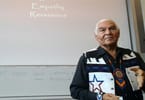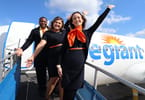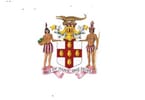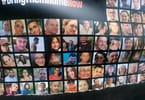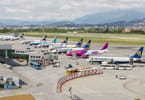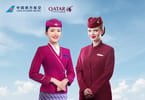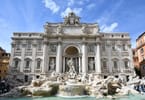Airline culture is all over the news. The hit movie “Up In the Air” stars George Clooney as a frequent flier. The Transportation Security Administration is under fire for allowing the online posting of airport screening secrets. And the holiday season is upon us, with millions of Americans ready to go airborne. Here are some uplifting facts:
1 A cat flew across the Atlantic Ocean eight years before Charles Lindbergh. The cat, named Wopsie or Whoopsie, was a stowaway aboard the dirigible R34 when it traveled from Scotland to New York in 1919. The cat wasn’t the only creature who beat Lindy to a trans-Atlantic flight. More than 80 people also did. But Lindbergh was the first to fly solo.
2 Qantas, the Australian airline, is a former acronym for Queensland and Northern Territory Aerial Services. That name is strange, but others may be stranger. Airline pilot Patrick Smith, who writes a column for salon.com, suggested that two of the worst airline names ever were Russia’s Kras Air (“always just an H away from infamy,” wrote Smith) and Taiwan’s U-Land Airlines (“That’s right. U-buy, U-fly and U-Land it yourself.”).
3 In 1987, American Airlines removed one olive from each first-class salad for a savings of about $40,000 a year. In a more recent cost-cutting move, American announced in 2004 that it would get rid of pillows on its MD-80 planes for an annual windfall of about $300,000. The next year, Northwest Airlines ditched free pretzels in coach class on its domestic flights, saving $2 million a year.
4 Joseph of Cupertino, a 17th century Italian priest, is a Roman Catholic patron saint of pilots and air passengers. Known as the “flying friar” because of his reported ability to levitate, Joseph annoyed his fellow churchmen, who banned him from attending choir or visiting the refectory for 35 years.
5 National Airlines launched an ad campaign in the early 1970s featuring attractive young flight attendants — then known as stewardesses — and slogans such as “I’m Margie. Fly me.” A group called Stewardesses for Women’s Rights picketed the airline’s offices and complained to the Federal Trade Commission about the ads. National was forced to tone down the campaign by including other airline workers. But somehow the idea of “flying” someone like, say, Ralph the baggage handler seemed a bit less alluring.
6 The producers of the 1980 comedy film “Airplane!” considered talk show host David Letterman and singer Barry Manilow for the lead role of washed-up pilot Ted Striker before settling on actor Robert Hays. The co-pilot played by basketball great Kareem Abdul-Jabbar was originally written for baseball star Pete Rose. According to the Internet Movie Database, Rose was offered $30,000 but lost the part after asking for $35,000, which he wanted to spend on an Oriental rug.
7 Ten soldiers boarded a plane at California’s Fort Hunter Liggett in the early 1960s, expecting a routine training mission. Instead, once they were airborne, the crew announced that an engine had stalled, the landing gear was inoperable and the plane would attempt to ditch in the ocean. Then the crew issued an odd demand: The soldiers would have to fill out insurance forms. After they dutifully did so, the plane landed, safely and routinely. The episode was an Army experiment to measure soldiers’ performance under stress. Not surprisingly, a control group on the ground filled out the same insurance forms more accurately.
8 Last December, passengers preparing to take off on an Aeroflot jet from Moscow to New York revolted when the pilot appeared to slur his words over the loudspeaker. Officials of the Russian airline tried to calm them. According to the Moscow Times, an airline official said, “It’s not such a big deal if the pilot is drunk. Really, all he has to do is press a button and the plane flies itself.” But the passengers stood their ground, and the crew was replaced. The incident was another black eye for Aeroflot, remembered for a 1994 flight in which a pilot let his 15-year-old son take the controls. The boy accidentally disabled the autopilot, sending 75 people to their deaths.
9 When Amelia Earhart helped organize the New York, Philadelphia and Washington Airways in the early years of commercial aviation, the in-flight lunch consisted of hard-boiled eggs and saltine crackers, chosen because they seemed unlikely to contribute to airsickness.
10 A passenger boarded a Chicago-bound plane in Washington, D.C., in 2003 and handed a note to a flight attendant, asking her to take it to the pilot. The note read, “Fast. Neat. Average.” The pilot had no idea what it meant and alerted authorities, who detained the passenger for questioning. The note was part of a well-known code at the Air Force Academy, based on cadets’ answers on a dining-hall survey. If all had gone well, the passenger’s note would have been returned with a note reading “Friendly. Good. Good,” and the passenger would have been invited to visit the cockpit. But the pilot was not an Air Force grad, and the passenger missed his flight. As an Air Force spokesman noted, “Obviously, the world has changed since 2001.”
WHAT TO TAKE AWAY FROM THIS ARTICLE:
- Instead, once they were airborne, the crew announced that an engine had stalled, the landing gear was inoperable and the plane would attempt to ditch in the ocean.
- The incident was another black eye for Aeroflot, remembered for a 1994 flight in which a pilot let his 15-year-old son take the controls.
- In a more recent cost-cutting move, American announced in 2004 that it would get rid of pillows on its MD-80 planes for an annual windfall of about $300,000.



